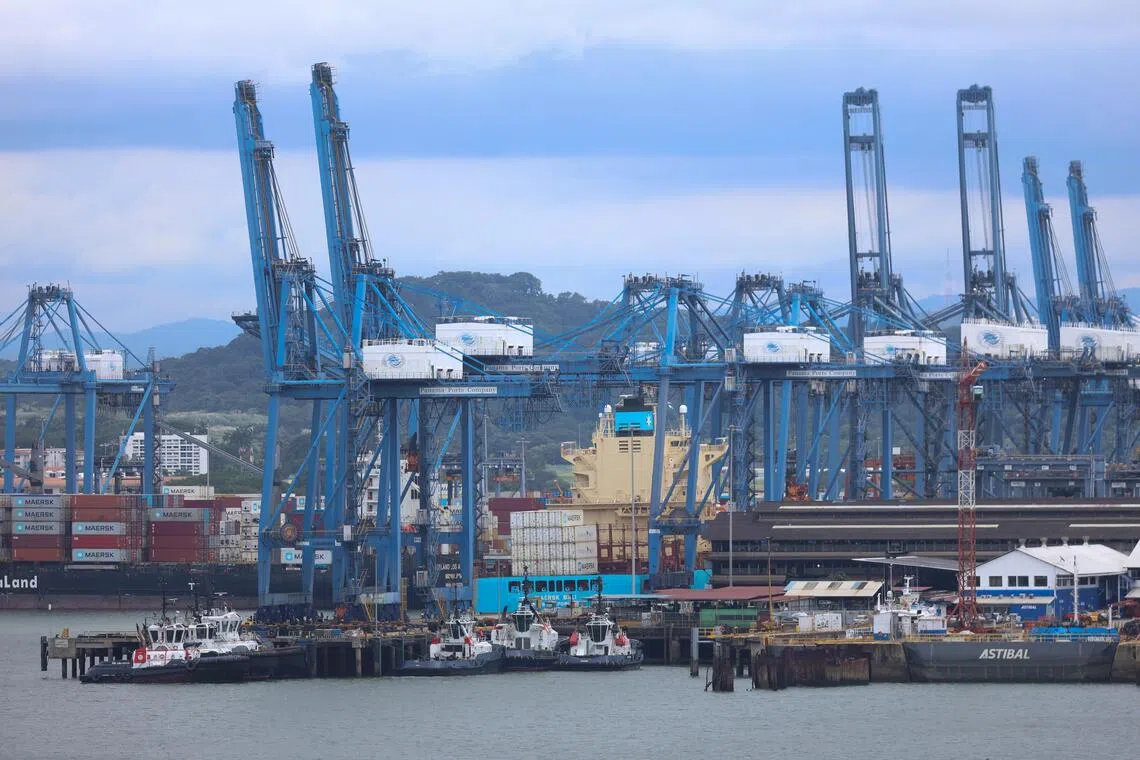S’pore’s PSA International among operators considered for Panama Canal’s twin terminal project
Sign up now: Get ST's newsletters delivered to your inbox

The new terminals aim to expand the canal’s container transshipment capacity by five million TEUs.
PHOTO: EPA
Follow topic:
- Panama Canal Authority seeks partners for two new container terminals on Atlantic and Pacific sides by Q4 2026, requiring US$2.6 billion investment.
- The project aims to increase transshipment capacity by 5 million TEUs, boosting Panama's intermodal hub position and creating 17,000 jobs.
- PSA International attended the meeting, already operates a Panama terminal, but declined to comment on its interest in this new project.
AI generated
SINGAPORE – Singapore’s PSA International was among major global port and shipping operators that attended a meeting to explore potential participation in a US$2.6 billion (S$3.4 billion) project to develop two new container terminals on the Atlantic and Pacific ends of the Panama Canal.
The Panama Canal Authority (ACP) said on Oct 27 that it had launched a consultation process with representatives of the maritime industry to identify potential partners for the project, which forms part of its 2025-2035 strategic vision to boost capacity and maintain the canal’s competitiveness as a global trade route.
Besides PSA International, companies invited to participate in the closed-door working session included APM Terminals, DP World, Cosco Shipping Ports, CMA Terminals, MOL, SSA Marine-Grupo Carrix, Hanseatic Global Terminals, and Terminal Investment Limited (TiL).
Major shipping lines such as Maersk, MSC, CMA CGM, ONE, Hapag-Lloyd, Cosco, Evergreen and ZIM also took part.
A market and feasibility study will be conducted for both terminals before a general project plan is developed. The process will then move into a pre-qualification and dialogue stage before the final selection of a concessionaire.
“The final phase of the concessionaire selection is expected to conclude in the fourth quarter of 2026,” ACP said.
The development is projected to have an estimated economic impact equivalent to between 0.4 and 0.8 per cent of Panama’s GDP. Construction and operations are expected to lead to more than 17,000 direct, indirect and induced jobs.
The new terminals aim to expand the canal’s container transshipment capacity by five million standard-size containers, or 20-foot equivalent units (TEUs), per year.
“(The terminals) will strengthen Panama’s position as one of the world’s most competitive intermodal hubs, and expand port capacity in the interoceanic area, which is currently operating near its limit,” ACP said.
PSA International already operates in Panama, where it runs a container terminal capable of handling two million TEUs at the Pacific entrance of the canal.
It was awarded the concession to build and operate the terminal on the site of a former US naval base in 2007, with container ship operations beginning in 2012. Work on expanding the terminal to its current capacity began in 2015, and in 2024, PSA Panama International Terminal handled a record 1.4 million TEUs, according to its website.
The Panama Canal is one of the world’s most critical maritime choke points, linking the Atlantic and Pacific oceans and cutting weeks off traditional shipping routes.
Control of terminals on either end of the canal gives port operators strategic access to global trade flows and transshipment traffic moving between the Americas, Asia and Europe.
When contacted, a PSA International spokesman declined to comment.
The two new terminals that Panama wants to develop are part of a 10-year US$8 billion investment plan to boost its economy, the ACP announced on Sept 16.
Aside from the two terminals, which will link the Atlantic and Pacific coasts, the plan includes a 76km liquefied natural gas pipeline with the capacity to transfer up to 2.5 million barrels per day.
According to the Journal Of Commerce, the ACP had planned to develop the Corozal container terminal on the Pacific side in 2016. However, none of the shortlisted companies, which included PSA International, submitted a bid at the time, and the project fell through.
PSA also declined to comment when asked why it did not move forward with the bid.
ACP is reviving the project after geopolitical wrangling between the US and China blocked the proposed sale of Hong Kong-based CK Hutchison’s 90 per cent interest
The deal, valued at US$23 billion, would have given BlackRock a controlling stake in PPC, which has a 25-year concession to operate two Panama terminals located at both sides of the canal.
However, Beijing blocked the deal, citing threats to China’s national interests. Hutchison is now expected to bring in Cosco, the state-owned shipping conglomerate, as a Chinese investor in the buy-side consortium.


